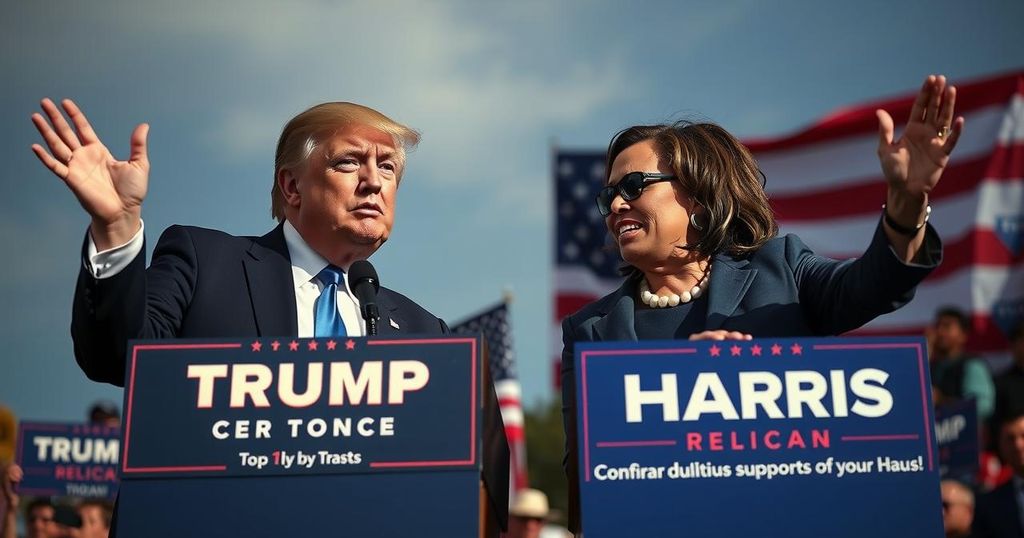Trump and Harris Compete for Latino Votes in Critical Swing States
Kamala Harris and Donald Trump are intensifying their campaigns in Arizona and Nevada, critical swing states where Latino voter turnout may influence the election outcome. Current polling shows Trump gaining ground among Hispanic voters, with Harris’ support dipping. Both candidates are focusing on engaging this significant demographic as the election approaches.
In the lead-up to the November 5 presidential election, both Kamala Harris and Donald Trump have intensified their campaigns in Nevada and Arizona, crucial swing states where Latino voter turnout may decisively influence the election outcome. On Thursday, both candidates engaged with potential voters in the Southwest, which boasts significant Latino populations. This demographic shift is noteworthy, as Latinos are projected to constitute a record 14.7 percent of eligible voters this year, historically leaning Democratic but trending towards Republican support in recent polling. Trump briefly visited Albuquerque, New Mexico, despite its anticipated irrelevance in the election, stating, “I’m here for one simple reason: I like you very much, and it’s good for my credentials with the Hispanic or Latino community.” Current polling from the New York Times/Siena indicates that Harris commands only 52 percent support among Hispanic voters, a drop from the 66 percent that supported President Biden in the previous election. Conversely, Trump has made gains, capturing 42 percent of the Hispanic vote. However, a recent rally incident, where a comedian made disparaging remarks about migrants, has led some Latino leaders to distance themselves from Trump and reinforce their support for Harris. The polling situation remains tense, as Harris and Trump are almost neck-and-neck. With both candidates planning further events in the battleground states, voter engagement among Hispanics and other demographics is imperative, particularly given the pattern of underrepresentation that has persisted in past elections. Currently, 62 million Americans have voted early, yet Hispanic voter participation lags significantly behind other racial demographics, comprising only 2 percent of early voters as reported by the Pew Research Center. In parallel, Black voters are voting early at a rate of 22 percent compared to their overall share of registered voters at 14 percent. Early indications show that women are also voting in greater numbers than men, which may bode well for Harris, who has emphasized reproductive rights throughout her campaign. Reinforcing their competing narratives, Harris recently condemned Trump’s remarks regarding women’s agency, arguing that his statements disregard their autonomy: “does not prioritize the freedom of women and the intelligence of women to make decisions about their own lives and bodies.” Trump, for his part, is banking on dissatisfaction with the Biden administration’s immigration policies to regain favor in Arizona, aiming to sway young, US-born Latino men in his direction. Political analyst Mike Madrid posits that the ultimate victor in this election may be determined by which candidate can best cultivate support from their traditional voting bases: “Republicans are placing their hopes on young, US-born, Latino men while Democrats are banking on the defection of more college-educated, white, Republican women. Whoever is right will win the race.”, As these candidates continue their campaigns, the stakes remain high, especially in states where demographics and voter engagement can pivot the electoral balance.
The increased focus on Latino voters in recently contested swing states reflects their growing political significance in the U.S. electoral landscape. As both major parties seek to mobilize this demographic ahead of the election, the candidates’ strategies revolve around addressing the specific concerns of these voters, particularly in immigration, economic opportunities, and social justice. Past elections have shown a tendency for Latino voters to lean Democratic, but shifts in sentiment, as highlighted in recent polling data, suggest an evolving political allegiance that both parties are eager to capitalize on. The upcoming election is anticipated to be fiercely competitive, with Latino turnout playing a pivotal role in determining the next president.
In summary, as the election date approaches, both Candidates Harris and Trump are actively vying for Latino support in Arizona and Nevada, recognizing the critical impact this demographic can have on electoral success. Despite historical loyalties to the Democratic Party, recent polls reveal that Trump is narrowing the gap among Hispanic voters, while Harris seeks to solidify her support through high-profile events and criticism of Trump’s policies. Early voting patterns indicate significant trends worth monitoring, particularly the underwhelming turnout rates among Latino voters compared to other demographics. With the race close, strategic outreach and engagement in these key communities may well determine the election’s outcome.
Original Source: www.aljazeera.com




Post Comment